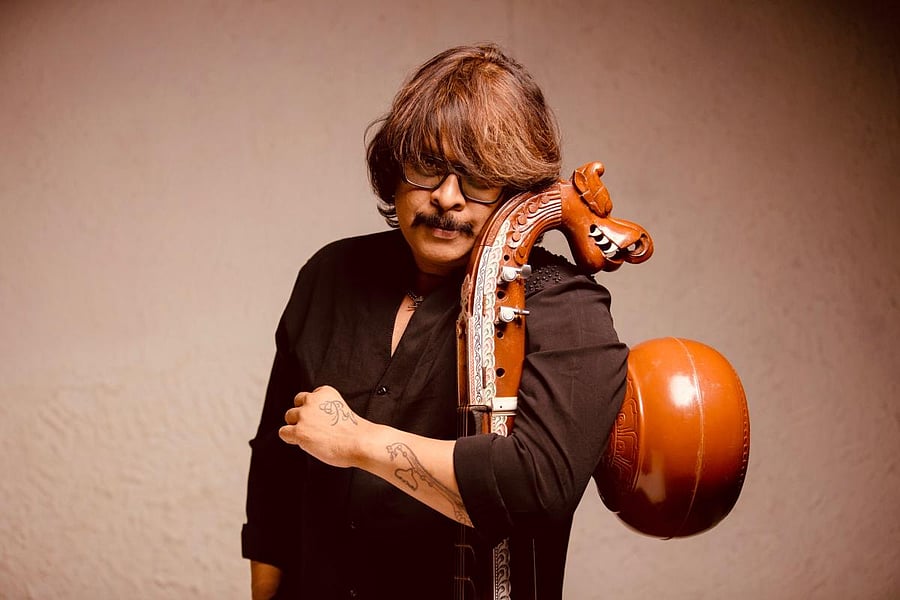
In his innovative music programmes, he electrifies audiences with his imaginative and free-spirited music. In a Carnatic music kutcheri, he impresses connoisseurs and critics with chaste classicism and fidelity to tradition. In both, however, his performances are characterised by their rich creativity, pitch perfection and flawless rhythm. That is Saraswati-veena maestro Rajhesh Vaidhya for you.
He was born into a musical atmosphere. His father K M Vaidyanathan was a rhythm stalwart in ghatam and mridangam. Legendary percussionist Vikku Vinayakram is Rajhesh’s uncle. Hence, it’s not surprising that Rajhesh trained in classical music and turned professional. However, what was the reason for choosing the Saraswati veena? He reveals: “I wanted to play the mridangam like my father but my mother insisted that I have to grow up to play the veena and moreover, I would have to learn the art from Guru C Chittibabu sir (a legendary vainika)! So, my profession was decided by my mother, and at age six!”
He continues: “My tutelage began at age six, in 1979 (now you know my age!) in Pondicherry. I learnt the basics from Ms Jayalakshmi and Rama Nambinarayanan.
I began advanced training from veena wizard Challapalli Shri Chittibabu sir in 1984. It was gurukulam training for three years. I also went with him to several performances. Years of observing him closely meant that, besides music, I learnt how to present oneself onstage, and the dos and don’ts of stage performances. I also imbibed a few mannerisms, consciously and unconsciously. This, I heard from connoisseurs who knew Chittibabu sir who said I reminded them of my guru in these mannerisms and in my playing style too!” Currently, Rajhesh is learning from eminent violinist L Shankar.
Rajhesh’s first performance was in Auroville, Pondicherry and his first solo concert was in Chennai in 1995. Gaining respect from audiences and critics alike, his career took off. Now, he is acclaimed as one of India’s finest vainikas with hundreds of performances to his credit in venues across India and abroad. He was made Shri Kanchi Kamakoti Peetham asthana vidwan in 2001, and awarded the prestigious Kalaimamani award in 2010.
Straddling different worlds
He straddles the worlds of classical music, fusion music and composing for TV serials and big-screen films with ease. Rajhesh has collaborated with top artistes like M Balamuralikrishna, U Rajesh, Purbayan Chatterjee, Pandit Vishwa Mohan Bhatt, etc. As a vainika, he was part of a French ballet ‘Bejart Ballet’ from 1997 to 1999, which featured Sir Elton John.
Talking of composing for TV and cinema, Rajhesh says “it has always been a dream. I have had the immense honour of association with renowned director K Balachander sir.”
He has composed title songs for several TV serials and has acted in a TV serial Premi. He is excited about the forthcoming release of his debut movie as music director, ‘Shot Boot-3’, directed by Arun Vaidyanathan.
What is the essential difference he finds among these genres? Rajhesh replies that, at heart, all of these are the same — it is all about making good music.
“However, working in my studio is about just me and a few accompanying musicians. Herein, I compose music where I have to wait eagerly and patiently for people’s reactions and comments...However, in a live concert, there are thousands of people assembled before me, watching me and the response can be immediately gauged — always a great feeling for a performing artiste!”
Talking of his innovations, the one making waves is his ‘Do You Have A Minute Series’ (DYHAMS), a 60-second music capsule. This series, with its very catchy title, features either a film song, part of a Carnatic composition or a raga delineation. It is showcased on all his social media platforms.
Like all contemporary musicians, Rajhesh is indeed aware of the power of social media to enable greater exposure to his art and build a connection with music lovers worldwide.
Also, the one-minute duration is obviously a nod to the shortened attention spans in today’s rushed world. He is a people’s musician in his readiness to play what the audience wants.
Why and how did DYHAMS originate? He reveals: “For a decade or so, I have had a segment at the end of my live concerts called Audience Request of 45-minute duration wherein I ask for and respond to audience requests. In 45 minutes, I end up playing around 75 to 80 songs. People are delighted to hear someone who performs their requests! Encouraged by this, I thought why not begin an online project; thus was born the one-minute series. When I began, I was only aiming at 40 or 50 songs i.e. 40 to 50 days.”
However, the immense and positive response prompted him to extend the series. “I recently completed 1,000 days. This means 1,000 days, 1,000 songs, 1,000 minutes — almost three-years nonstop!”
For those curious about his tattoos, the one on the left arm is a Saraswati veena.
The one on the back of his palm has his initials with a heart in between. “Well, I love myself and my Saraswati veena so that explains the tattoos,” he says with a laugh.